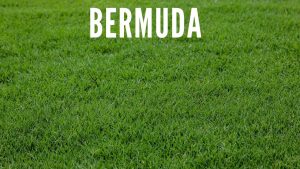Bermuda grass Identification
To establish whether you’ve got Bermuda grass on your lawn, you simply need to look out for a few notable characteristics of this species, which are discussed in detail below:
Characteristics of Bermuda Grass
- Bermuda grass thrives in warm climates, with March-September being its peak growing season. Few other warm-season kinds of grass spread faster than Bermuda grass. Therefore, if you notice a fast-spreading grass type on your lawn during summer, it could quite possibly be Bermuda grass.
- Bermuda grass lengths vary anywhere from 4-12 inches, with pointed leaves.
- Bermuda grass flowers appear at the tip of the stem, forming purple branches and egg-shaped seeds that lend the flower stalks their spiky appearance.
- Bermuda grass boasts fibrous roots and extensive rhizomes. You can gauge the maturity of a single Bermuda grass plant by looking at the color of the roots; as young Bermuda roots are typically white, adopting a brownish-yellow hue upon maturity. The rhizomes facilitate underground growth, while the stolons foster above-ground growth.
- Bermuda grass varieties aren’t exactly cold-tolerant, which is why they go dormant during the colder seasons, only to start spreading again around spring. Therefore, if you notice a grass species on your lawn that has been dormant during winter but is starting to thrive with the return of the warmer seasons, it’s highly likely that it’s Bermuda grass.
- Bermuda grass plants typically develop collar-region hair tufts- a characteristic that isn’t shared by other types of lawn grasses.
- Bermuda grass typically has roots shooting off from the nodes at intervals.
- Bermuda grass turfs are typically dense.
See also my articles on:
Tall Fescue Identification
Characteristics of Fescue Grass
- Rolled vernation- vernation refers to the arrangement of the youngest grass blades in the shoot. As such, young tall fescue leaves feature rolled vernation, whereby they assumed a circular pattern within the shoot- with no folds. To check for the type of vernation, you should place a tall fescue shoot between your first two fingers and then roll it. If it rolls smoothly- like a cylindrical object lying on its sides– it implies rolled vernation and the grass species you’re dealing with could quite possibly be tall fescue.
- Has no auricles- unlike many other lawn grass species, tall fescues lack these slender collar extensions that cling around the shoot and are typically located at the cross-section of the leaf blade and the sheath.
- Has short, membrane-filled ligules- while most warm-season turfgrasses have hairy ligules or none at all, cool-season grasses like tall fescue feature membranous ligules.
- Has panicle-style seed heads- if you haven’t mowed your lawn in a while, then the seed head is one of the best features to assess when determining what type of turfgrass you’ve got growing on your property. In this regard, while other grass species may feature spike-type or racemes seed heads, tall fescue grass boasts panicle-type seed heads.
- Bunch-type growth pattern- tall fescue grass turfs spread via rhizomes (sometimes) and more commonly- tillers. Turfgrass species that produce tillers but no rhizomes or stolons are known as bunch-type grasses.
- Leaf-blade structure- tall fescue grass features blades with numerous, similar-sized veins; unlike most other turfgrass species that have a prominent mid-vein spanning the entire length of the blade. What’s more, the underside of the tall fescue leaf blade is dull; a far cry from the shiny appearance found beneath the leaf blades of other types of turfgrass. Finally, the tips of tall fescue grass leaves are pointed, not keeled; as is the case in many other species of lawn grasses.
Differences: Bermuda grass vs Fescue Grass
While they may both be considered lawn grasses and share a few similarities here and there, Bermuda grass and fescue grass are quite different. Below is a table detailing the differences between these two types of turfgrass.
|
Bermuda grass
|
Fescue grass
|
| Is a warm-season grass that grows best in tropical climates/warm regions. | Is a cool-season grass that grows best in colder regions. |
| Tends to thrive during spring and summer and goes dormant during winter | Tends to thrive during fall, winter, and spring seasons; losing its lush color during the hot summer seasons |
| Has great heat tolerance, salt tolerance, and drought resistance; but poor cold tolerance and shade tolerance. | Has poor heat tolerance, salt tolerance, and drought resistance; but great cold tolerance and shade tolerance. |
| Recovers quite fast from wear due to heavy foot traffic | Takes a longer time to recover from wear due to heavy foot traffic |
| Has a moderate recommended mowing height of no more than one-and-a-half inches | Has a higher recommended mowing height- usually one-and-a-half- inches or more. |
| When left uncut, Bermuda grass can grow to a maximum height of twelve inches | Heights of up to four feet have been recorded before for fully matured fescue grass. |
| Bermuda grass spreads through stolons and rhizomes; with some species being capable of producing seeds. | Fescue grass lawns are usually established by seed or sod. |
| Highly vulnerable to fungal infections | Less vulnerable to fungal infections |
| Bermuda grass is highly invasive, with the tendency to spread into landscaping areas where it isn’t wanted; such as the flower garden or the pavement | Despite being a deep-rooted grass species, tall fescues aren’t as invasive as Bermuda grass |
| Bermuda grass varieties have a combination of various shades of green | Tall fescue has a characteristic lush green color |
Shop My Recommended Bermuda Grass Seed
Affiliate links and images pulled from the Amazon Product Advertising API on: 2025-07-09
Shop My Recommended Fescue Seed
Affiliate links and images pulled from the Amazon Product Advertising API on: 2025-07-09
Hi, Alex Kuritz here. Growing up I remember that my family had one of the best lawns in the neighborhood. Richly green and lush. I did a lot as I grew up in terms of caring and tending for not only my family’s lawn but also my neighbors. I can say I have years of experience, and I am here to share it with you.






Found lots of good information!